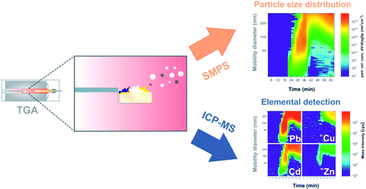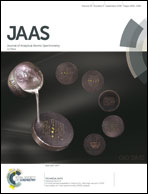Combustion generated nanomaterials: online characterization via an ICP-MS based technique. Part II: resolving power for heterogeneous matrices†
Abstract
Among the available online techniques to characterize combustion generated nanomaterials, the recently developed RDD-SMPS-ICP-MS (rotating disc diluter-scanning mobility particle sizer-inductively coupled plasma-mass spectrometry) setup is here suggested, due to its ability to provide simultaneously size-resolved elemental and quantitative information with a high time resolution. The successful calibration strategy presented in Part I will be applied here. To assess the resolving power of the technique regarding the elemental composition, two different applications with complex heterogeneous matrixes were considered: a mixture of several metal chlorides particles generated by the reaction of metal oxides (PbO, CdO, CuO, ZnO) with CaCl2·2H2O and secondary formed ZnO nano-objects released during the combustion of impregnated wood. The latter, especially, allowed considering the effect of the heterogeneous nature of a realistic process gas sample, where several gas species are emitted. The results of these experiments showed the ability of the SMPS-ICPMS system to distinguish and quantify the single contribution of a specific element in the overall particle size distribution (PSD).

- This article is part of the themed collection: 2018 Winter Conference of Plasma Spectrochemistry, Amelia Island, FL, US


 Please wait while we load your content...
Please wait while we load your content...